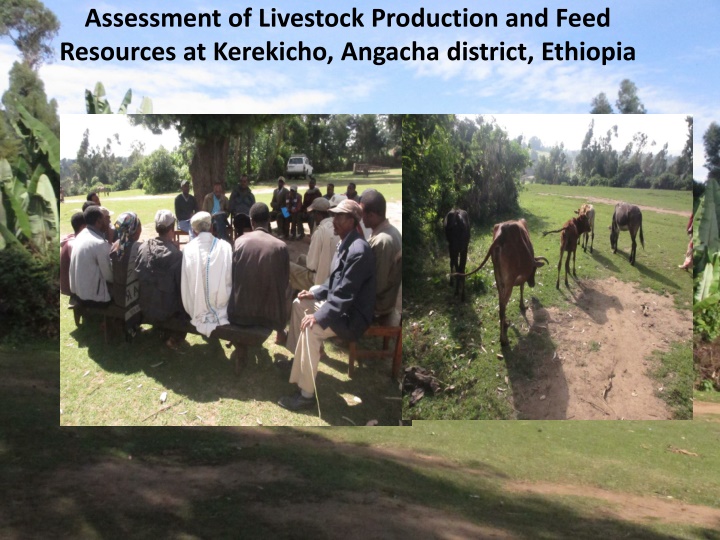
Livestock Production Assessment in Kerekicho, Angacha District, Ethiopia
Explore the livestock production and feed resources assessment conducted in Kerekicho, Angacha District, Ethiopia. Learn about the objectives, methodology, results, and discussions regarding livestock production constraints and potential intervention strategies. Discover the main livestock production challenges in Abiy and Gutoso sub-villages and the suggested solutions for each issue.
Download Presentation

Please find below an Image/Link to download the presentation.
The content on the website is provided AS IS for your information and personal use only. It may not be sold, licensed, or shared on other websites without obtaining consent from the author. If you encounter any issues during the download, it is possible that the publisher has removed the file from their server.
You are allowed to download the files provided on this website for personal or commercial use, subject to the condition that they are used lawfully. All files are the property of their respective owners.
The content on the website is provided AS IS for your information and personal use only. It may not be sold, licensed, or shared on other websites without obtaining consent from the author.
E N D
Presentation Transcript
Assessment of Livestock Production and Feed Resources at Kerekicho, Angacha district, Ethiopia
Background Kerekicho kebele Kerekicho kebele is one of the 28 kebeles in Angacha woreda The area has an average elevation of 2280 masl main production system in the kebele is mixed crop livestock production system where Enset (Ensete ventricosum) is the major food for humans and feed for livestock It is estimated that close to 900 household heads are residing in the kebele
Objectives To assess rapidly the prevailing farming and livestock production system, feed resources availability and livestock production constraints To identify potential intervention strategies for the development of livestock feed resources.
Methodology Discussions were made with the Africa RISING project, Lemo site coordinator, Kerekicho kebele administrators and development agents Three sub-villages were purposively selected from the whole kebele based on the availability of irrigation practice A total of 45 farmers (15 from each sub-village) were selected All the farmers were selected based on wealth category (small, medium and large landholdings) Out of the 15 farmers selected farmers (6 male and 3 female) representing the three wealth categories were interviewed to collect quantitative data in each sub-village, 9
Result and discussions Landholding.pptx Crop production.pptx Livestock production.pptx Feed Resources improved fodders grown.pptx Purchased feeds.pptx Household income sources.pptx Contribution available feed resources to the total dry matter.pptx Contribution available feed resources to the total metabolizable energy.pptx Contribution available feed resources to the total crude protein content.pptx Feed resource availability and rainfall patern.pptx
Main livestock production constraints Table 1 Abiy sub-village Problems listed Suggested solutions Problems Livestock feed shortage Establish improved forages at backyards and multiply them Training on crop residue treatment techniques 1 Knowledge gap on livestock husbandry and management Training and awareness creation by concerned expertise Experience sharing on best practices 2 Lack of improved dairy cattle breeds Improve artificial Insemination service coverage Improved bull and semen services Select local cattle breeds and cross them 3 Limited animal health services Assigning animal health workers at the kebele level 4 Table 2. Gutoso sub-village Problems listed Suggested solutions Problems 1 Limited knowledge/awareness on livestock management and husbandry Livestock feed shortage Proper extension service and training on livestock husbandry, management and production Experience sharing on best practices Allocate land to establish improved forages at backyards. Improve crop residue storage. Training on crop residue treatment and utilization Select local cows and cross them with exotic semen To use community based bull service Allocate AI technician in the kebele Make services available at kebele level Training for farmers to provide community based animal health service 2 3 Lack of improved dairy cattle breed 4 Limited animal health services
Main livestock production constraints. Problems listed Suggested solutions Problem s 1 Limited knowledge/awareness on cattle management and husbandry Proper extension service and training on livestock husbandry, management and production Experience sharing on best practices Improve utilization of crop residue Training on establishment of improved forages To provide credit service to purchase concentrate feeds Improve bull service Promote AI services and improve availability Assign animal health workers in the kebele 2 Livestock feed shortage 3 Lack of genetically improved dairy cattle 4 Lack of animal health services
Conclusion and suggestions for future intervention Introduce improved forages and link to the existing irrigation practice Support farmers with training on how to establish and utilize improved forages Provide training on the alternative means of improving the quality of existing crop residues The existing practice of feeding enset leaves to livestock need to be further investigated to come up with appropriate utilization High demand for dairy and dairy products in the area need to be addressed Training and awareness on overall improved management and husbandry practices
